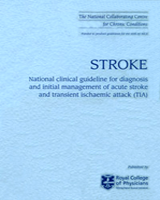All rights reserved. No part of this publication may be reproduced in any form (including photocopying or storing it in any medium by electronic means and whether or not transiently or incidentally to some other use of this publication) without the written permission of the copyright owner. Applications for the copyright owner’s written permission to reproduce any part of this publication should be addressed to the publisher.
NCBI Bookshelf. A service of the National Library of Medicine, National Institutes of Health.
National Collaborating Centre for Chronic Conditions (UK). Stroke: National Clinical Guideline for Diagnosis and Initial Management of Acute Stroke and Transient Ischaemic Attack (TIA). London: Royal College of Physicians (UK); 2008. (NICE Clinical Guidelines, No. 68.)
In May 2019, NICE updated and replaced this guideline with NICE guideline NG128 on stroke and transient ischaemic attack in over 16s. Some of the 2008 recommendations have been retained in the new guideline. This 2008 full guideline includes the evidence supporting the 2008 recommendations. Sections of the guideline CG68 that have been updated are shaded in grey in the PDF.

Stroke: National Clinical Guideline for Diagnosis and Initial Management of Acute Stroke and Transient Ischaemic Attack (TIA).
Show details12.1.1. Clinical introduction
Aspiration pneumonia may be a devastating complication of stroke and is associated with increased mortality and poor outcomes. 40% of patients with stroke acutely have swallowing difficulties, some of which may not be detectable clinically. Those assessed as having dysphagia are recommended a variety of options for oral intake, from no oral intake, through modification of fluid (small volumes, thickened fluids) and food (puree or soft consistency) to normal intake. It is common sense that patients who aspirate oral contents should not be fed orally, but little is known about the safety of water by mouth. Normal saliva production is 1–2 litres per day, so even patients denied access to oral fluids are aspirating large fluid volumes. Patients are often much more distressed by withdrawal of fluids than of food, and despite adequate fluid replacement by other means (intravenous or subcutaneous infusions or tube feeding) feel thirsty and have a dry mouth. Oral hygiene is very much more difficult to maintain in patients denied oral fluids, and aspiration of infected saliva may contribute to the development of pneumonia.
The clinical question to be addressed is how best to reduce the likelihood of patients with acute stroke developing aspiration pneumonia.
12.1.2. Clinical methodological introduction
One RCT was identified that compared acute stroke patients within 3 weeks of stroke onset with previously identified thin liquid aspiration (verified by videofluoroscopy) (N=20). Groups were randomised between those who were given thickened liquids plus additional water compared with those given thickened liquids only.187 Level 1+
The patient population had a mean age of 77 years. In the group given thickened liquids with additional water, five of the patients had consistent aspiration of thin liquids (>50% of swallows), four had inconsistent aspiration of thin liquids (10 to 15% of swallows) and one had infrequent aspiration of thin liquids (<10% of swallows). Seven of the patients had an absent protective cough reflex at the level of the vocal folds. Level 1+
In the control group (thickened liquids only), two patients had inconsistent aspiration and six infrequent aspiration. Five of the patients did not have a protective cough reflex at the level of the vocal folds. Level 1+
12.1.3. Health economic methodological introduction
No papers were identified.
12.1.4. Clinical evidence statements
End point of no thin aspiration
There was no statistical difference between patients given thickened liquids and access to water compared with those on thickened liquids only with respect to the time taken to reach the end point of no thin liquid aspiration (NS).187 Level 1+
Daily intake of liquids
Patients on thickened liquids only had a statistical higher intake of thickened liquids compared to those on thickened liquids with additional water.187 Level 1+
Follow-up videofluoroscopic evaluations
There was no statistical difference between patients with thickened liquids and access to water compared with those on thickened liquids only (NS) with respect to the number of follow-up videofluoroscopic evaluations (NS).187 Level 1+
Complications
No patients developed pneumonia, dehydration, or complications during the course of the study or at 30-day follow-up.187 Level 1+
12.1.5. From evidence to recommendations
There is insufficient evidence addressing the withdrawal or modification of oral intake in the prevention of aspiration pneumonia after stroke. One study showed that the modification of oral intake through thickened fluids was not as unsafe as the group had expected. No studies were identified which addressed the issue of giving water to patients who are assessed as having dysphagia for fluids. The withdrawal or modification of oral intake when trying to prevent aspiration pneumonia is a contentious issue amongst healthcare professionals and the insufficient evidence highlights the need by the group for a research recommendation in these areas. There was a consensus that an important reason for giving patients water would be to enable them to maintain adequate oral hygiene and to reduce patient distress. The consensus of the group was that there was insufficient evidence on which a recommendation could be made.
12.1.6. RECOMMENDATION
- R56.
In people with dysphagia, food and fluids should be given in a form that can be swallowed without aspiration following specialist assessment of swallowing.
- Avoidance of aspiration pneumonia - StrokeAvoidance of aspiration pneumonia - Stroke
- Immunosuppressive AgentsImmunosuppressive AgentsAgents that suppress immune function by one of several mechanisms of action. Classical cytotoxic immunosuppressants act by inhibiting DNA synthesis. Others may act through act...<br/>Year introduced: 1966(1964)MeSH
- Gnat1 G protein subunit alpha transducin 1 [Rattus norvegicus]Gnat1 G protein subunit alpha transducin 1 [Rattus norvegicus]Gene ID:363143Gene
Your browsing activity is empty.
Activity recording is turned off.
See more...
